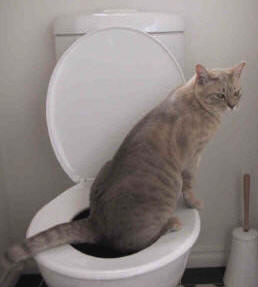Prevent Plumbing Problems: Never Flush Cat Poop Down Your Toilet - Professional Guidance
Prevent Plumbing Problems: Never Flush Cat Poop Down Your Toilet - Professional Guidance
Blog Article
Were you trying to locate information concerning How to Dispose of Cat Poop and Litter Without Plastic Bags?

Intro
As cat proprietors, it's necessary to bear in mind exactly how we throw away our feline good friends' waste. While it might seem practical to flush feline poop down the commode, this method can have destructive repercussions for both the atmosphere and human health and wellness.
Ecological Impact
Flushing pet cat poop introduces harmful microorganisms and parasites into the water, posing a substantial risk to water ecosystems. These pollutants can adversely influence aquatic life and concession water quality.
Health Risks
In addition to environmental concerns, purging pet cat waste can additionally present health and wellness dangers to humans. Cat feces might include Toxoplasma gondii, a bloodsucker that can create toxoplasmosis-- a potentially extreme ailment, particularly for pregnant ladies and people with weakened body immune systems.
Alternatives to Flushing
Fortunately, there are more secure and much more accountable means to dispose of pet cat poop. Consider the complying with choices:
1. Scoop and Dispose in Trash
The most usual method of dealing with feline poop is to scoop it right into an eco-friendly bag and throw it in the trash. Be sure to use a devoted clutter inside story and deal with the waste immediately.
2. Use Biodegradable Litter
Opt for biodegradable pet cat clutter made from materials such as corn or wheat. These litters are environmentally friendly and can be safely dealt with in the trash.
3. Bury in the Yard
If you have a yard, think about burying pet cat waste in a marked area far from vegetable yards and water resources. Be sure to dig deep enough to avoid contamination of groundwater.
4. Install a Pet Waste Disposal System
Buy an animal garbage disposal system particularly made for feline waste. These systems make use of enzymes to break down the waste, decreasing smell and environmental effect.
Conclusion
Liable animal possession prolongs past providing food and sanctuary-- it also entails proper waste administration. By avoiding flushing pet cat poop down the bathroom and selecting alternative disposal methods, we can reduce our environmental footprint and protect human health and wellness.
Why You Should NEVER Flush Cat Poop (and/or Litter) Down Your Toilet
The Problem with Litter
The main function of litter is to solidify and adhere to your cat’s waste. While this makes litter excellent for collecting cat poop and urine, it’s also the exact property that makes it a nightmare when flushed down the toilet.
Cat litter can and will clog pipes. There is non-clumping litter, but it’s still quite heavy and can build up in pipes. This is true even of supposed “flushable litter.”
The problems only compound when the litter is already clumped into cat waste. Toilet paper is among the more flushable things, and even too much of that will clog a toilet.
The Problem with Cat Poop
Sewers and septic systems are designed with human waste in mind. The microbes that help break down human waste don’t work on cat waste. Additionally, cat poop plays host to the parasite Toxoplasma gondii.
When flushed, this parasite can enter the environment in places it was never meant to, posing a risk to pregnant women, their unborn children, and other people with compromised immune systems. While it might not seem possible, flushing cat poop can indeed introduce this parasite to the public water supply.
These reasons are why, even if you’ve trained your cat to go on the toilet and flush, which is possible, it’s still not a good idea. Also, pregnant women and the immunocompromised shouldn’t change litter, either.
How to Handle Litter
The best way to handle litter is to simply put it in a plastic bag and place it in the trash. Avoiding environmental risks and possible plumbing damage is worth the extra effort.
You can also invest in devices that seal away your cat’s waste in a separate compartment, so you don’t have to change the litter nearly as often. They’re also safer for pet owners because they limit the possibility of Toxoplasma gondii exposure.
Disposing of litter the old-fashioned way will ensure you won’t have to worry about any issues that flushing the waste can potentially cause.
Take Care of Clogged Pipes with Stephens Plumbing, Heating & Air Conditioning
The reasons you should never flush cat poop down your toilet are numerous, but sometimes the inevitable happens despite your best efforts.
Stephens Plumbing, Heating & Air Conditioning is ready to help if you’re experiencing litter-blocked plumbing. Whether you need us in an emergency or want to schedule regular maintenance, we’re here for you.
https://www.stephensplumbing.net/bathroom-plumbing/never-flush-cat-poop-down-your-toilet/

We were made aware of that write-up on How to Dispose of Cat Poop and Litter Without Plastic Bags from an acquaintance on our other web page. Those who appreciated our article kindly make sure you remember to share it. Thank-you for your time spent reading it.
About This Report this page